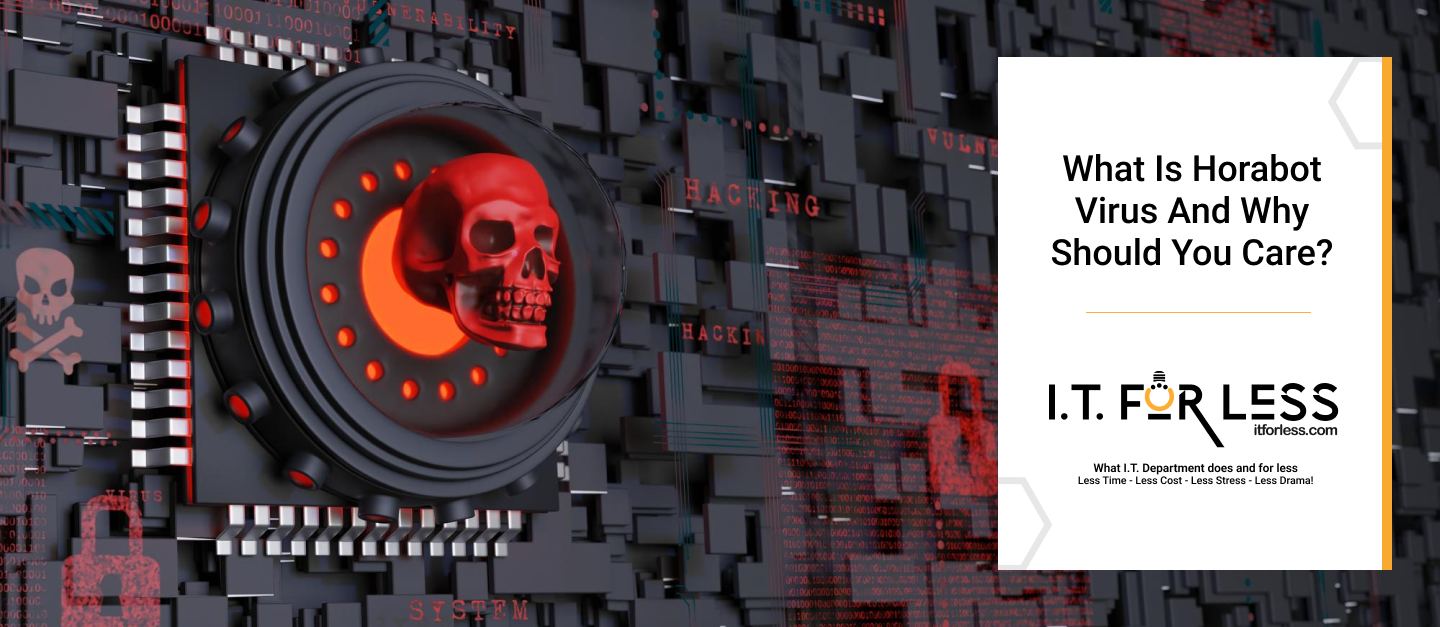Horabot malware is on the rise without any plans of slowing down. In the past quarter alone, security researchers have observed a 40% increase in Horabot’s phishing campaigns, targeting businesses across North America with fake invoices and urgent payment notices.
What began as a localized threat in Latin America has evolved into a global danger. Unfortunately, protecting against Horabut Malware demands more than a one-off antivirus scan.
Read on as we discover what is Horabot Malware and why should US businesses care about its quick widespread.
What Is Horabot?
Horabot is not just another virus lurking in the background—it’s a full-scale malware campaign with two jobs: steal your information and spread itself as far as possible.
It combines a Remote Access Trojan (RAT) with a banking trojan. In simpler words, once it lands on one device in your organization, it can:
- Take screenshots of your activity
- Log your keystrokes
- Steal banking and email credentials
- Send out infected emails from your inbox
Horabot viruses create lasting impact on your I.T. infrastructure. It does so by embedding into your business and using your communication tools to infect others.
This can include:
- Vendors
- Clients
- Team Members.
The strategy behind its attack is simple: find businesses with light defences, hijack their email, and let the malware spread itself using existing trust relationships.
The Origins of Horabot Malware
Horabot first surfaced in Latin America, where it targeted small and mid-sized businesses with poorly protected email systems. The initial infections were easy to overlook. They often were a single attachment disguised as an invoice, or a link pretending to be a bank notification.
Hackers patched this vulnerability, making the Horabot rely on better social engineering tactics. Once these campaigns proved successful, the malware began spreading into U.S. markets.
Fast forward to today, Horabot has become a part of wider phishing campaigns aimed at industries that rely heavily on email communication. These include:
- Financial services
- Legal firms
- Consulting practices
- Other small-to-mid-sized service providers.
How Does Horabot Spread?
It doesn’t barge through the front door—it waits for someone to open it.
The most common entry point is a phishing email. You or someone on your team receives what looks like a normal document: a fake invoice, a payment confirmation, or a bank statement. One clicks on the attachment, and Horabot quietly installs itself in the background.
From there, it does two things:
- Begins collecting data and access credentials
- Uses your email to send out more infected messages to your contacts
Because the emails are coming from a known source—you—the likelihood of someone else opening them is much higher. That’s how it moves from one inbox to another, flying under the radar and gaining ground before anyone notices.
Which Business is Horabot Malware Targeting?
In the early days, Horabot focused on small businesses in Latin America. But today, it’s moved well beyond borders and industries.
Here’s who’s most at risk right now:
- Small to mid-sized businesses (SMBs) with limited IT security infrastructure
- Financial services, legal practices, real estate firms, and professional consultancies
- Organizations relying on email for client communication
- Companies with remote or hybrid workforces using personal or unmonitored devices
Why these businesses? Because attackers know they’re less likely to have 24/7 monitoring, updated patches, or regular staff training. In other words, they’re easier to breach and less likely to detect the malware before it spreads.
Why Is Horabot So Dangerous?
Because it doesn’t just steal data—it uses you to do it.
Think about it: if someone hijacked your inbox right now, how many people would open that next email without hesitation?
Clients, partners, coworkers. So, it’s not just your business at risk. It’s everyone connected to you.
Some of the real risks Horabot brings with it include:
- Loss of client trust: when infected emails come from your domain
- Financial fraud: If your banking credentials become compromised, it can lead to financial fraud committed by the attackers.
- Network-wide Interruption: Horabot deploys infections that impact servers, backups, and cloud tools
- Compliance issues: If your business is a part of an industry handling sensitive data, it can lead to legal complications.
- Reputational damage: If your customer data is leaked, it can take months (or years) to repair the brand reputation to your business.
Your Silver Lining: Protect Your Business Against Horabot – and For Less!
Most small businesses don’t have in-house cybersecurity departments. And even if you’ve got an IT person or a vendor on call, responding to threats like Horabot takes more than break-fix support. It takes strategy.
That’s where I.T. For Less comes in.
We don’t just react when something goes wrong—we put systems in place to stop things from going wrong in the first place. Here’s how we help:
- Phishing and malware filtering at the email level before messages ever hit your inbox
- 24/7 monitoring to flag unusual activity in real time
- Endpoint protection to safeguard each device connected to your network
- Patching and updates to keep systems hardened against known exploits
- Employee training to turn your team into your first line of defence
- Secure backups that allow you to recover fast if anything does slip through
It’s not about adding more tools. It’s about designing the right system for your business—and managing it with intention.
Final words
Most companies only react to threats after the damage is done. That’s not protection — that’s patchwork. At I.T. For Less, we don’t chase symptoms. We help you build systems.
We help you strengthen every part of your digital infrastructure — your people, your processes, your policies, and your protections — because cybersecurity isn’t one department’s job. It’s a business function.
If your business is growing, it’s time your IT strategy grew with it. Let’s build a smarter, safer business — together.
